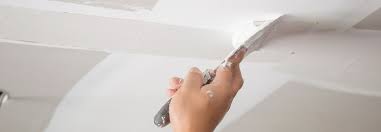Drywall is a common residential material, but it can get damaged. This makes your home less energy efficient because heat and air conditioning escape through the holes and cracks in drywall.
Most drywall damage is minor and can be repaired easily by do-it-yourselfers. But there are some situations where you need to call in an expert.
1. Damaged Drywall
Damaged Drywall Repair Charleston SC is one of the most common problems that homeowners face, and not only does it look ugly, it can also be dangerous. Whether you’re dealing with small indentations or larger holes, it’s important to repair them as soon as possible.
Waterproofing Foundation Walls can significantly help in preventing such damages by ensuring that moisture doesn’t seep into the walls, thus reducing the risk of mold growth and structural issues. Investing in proper waterproofing can save you from extensive drywall repairs in the long run.
Cracks in Foundation may exacerbate drywall issues, as they can lead to shifts in the structure of your home. These shifts may result in new or worsened cracks in your drywall, creating a cycle of damage that can be costly and challenging to fix. If left unaddressed, these foundation cracks can compromise the stability of your entire home.
Drywall is made up of thin sheets of paper that are attached together with joint compound. The drywall is then covered with paint to give it a smooth and finished look.
It can be damaged by many things, including impacts from doorknobs and furniture, faulty electrical wiring, and even plumbing leaks. However, there are plenty of ways to get rid of these small dents and holes.
2. Water Damage
Water damage is a serious problem for homeowners. Not only does it have the potential to cause health problems, but it can also be a costly repair job.
Sump Pump Battery Backup is a crucial component of any comprehensive water damage prevention plan. By maintaining power to your sump pump even during electrical outages, it ensures that your basement stays dry and free from floodwaters. Whether you live in an area prone to heavy rainfall or simply want to safeguard your home against unexpected emergencies, a reliable battery backup for your sump pump is a wise investment.
The most common issue is a flood or leak, but there are other causes as well. Clogged gutters, rusty pipes, faulty appliances, and extreme temperatures all contribute to water damage.
Once a leak or flood occurs, it quickly spreads and soaks into floors, walls, soft furnishings, and more. This can lead to mold growth, rotting wood, and structural issues.
This is why it’s so important to act quickly to fix water damage if you find any signs of leakage in your home. If you don’t, it may be too late and the damage will be permanent.
3. Mold or Mildew
Mold is a type of fungi that grows on areas of your home that are moist or damp. It commonly grows in basements, shower walls and windowsills.
Toxic mold can cause serious health issues if it is left untreated. It can secrete chemicals that cause allergies, respiratory issues and heart problems.
When drywall is damaged by water and mold, it may become more porous than normal. This is a major concern, since porous materials like drywall can host microscopic mold spores that remain unseen in the pores of the material.
4. Cracked Drywall
Cracked Drywall Ceiling can be a common result of these settling and deflection issues. Whether it’s hairline cracks or more significant ones, addressing drywall damage is crucial to maintain the structural integrity and aesthetic appeal of your home. If left unattended, these cracks can worsen over time, leading to more extensive and costly repairs.
Drywall is a gypsum-based material covered with a paper that adds strength and a smooth finish. It can crack when two sheets of drywall meet.
These cracks usually occur at the seams where drywall gets taped and filled with drywall mud. They also sometimes appear where drywall gets butted together.
They’re typically hairline, but larger diagonal cracks can indicate serious foundation problems that will require professional repair.
When a home settles or deflects, drywall may crack around windows and doors as well as near beams and support posts. These are normal occurrences that are often associated with lumber shrinkage and foundation settlement.
5. Popped Nails or Screws
Nail pops are a common problem that show up in both walls and ceilings. They aren’t a serious structural issue, though in great enough numbers they can cause your wall to lose a section of drywall.
Generally, they are caused by shrinkage of the lumber behind your drywall. This is a natural process that happens when the lumber has a high moisture content.
When the drywall gets installed Drywall Repair Charleston, it tries to keep the lumber from absorbing more moisture. That can cause the lumber to actually shrink and pull or push things against it in the direction of that shrinkage.
Conclusion
When this happens, a drywall screw that is too deep will not hold tight to the drywall, so it can pop when there’s movement in the framing or other impact on the wall or ceiling. It may not be a serious problem, but it should be addressed before it gets too bad.








